City Focus: Saint-Nazaire
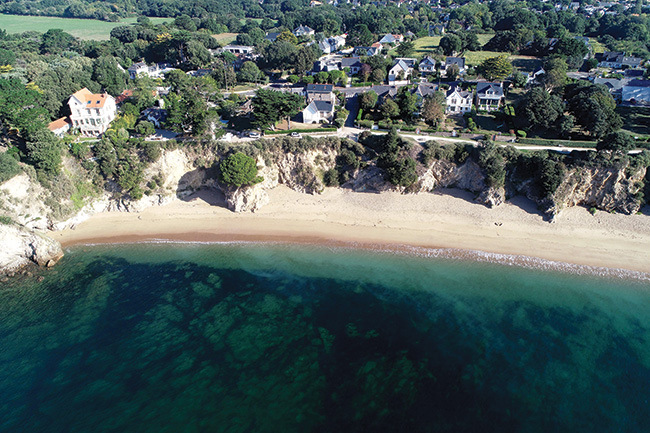
Located discreetly to the east of tourist resorts such as Pornichet and La Baule, and one hour west of its big-sister city of Nantes, Saint-Nazaire is often overlooked and nearly always underestimated. Yet it has a warrior’s heart and bears its battle scars with pride, as Annaliza Davis explains.
Until 1862, little had changed for centuries in the quiet coastal village of Saint-Nazaire, home to fishermen, sailors and their families; but their destiny was forever altered when it was chosen to become the outer harbour for Nantes. Shipyards sprang up, the population boomed and the CGT shipping company – known to us as The French Line – set up base here, making Saint- Nazaire the departure port for Central America. Today, when you look across the waves towards America, you can imagine quaysides buzzing with travellers preparing to set sail for Central America, a voyage that took 24 days.
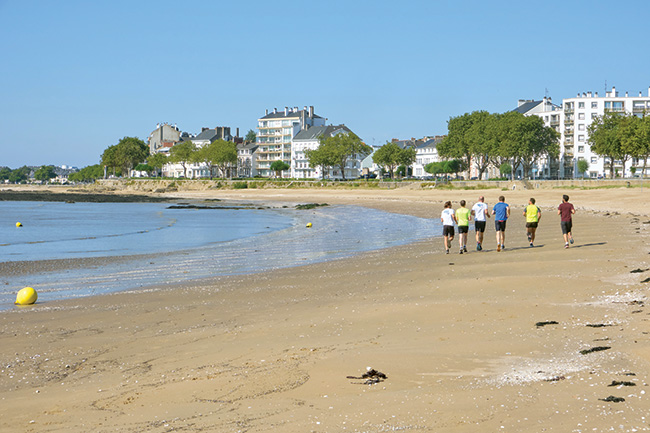
The beach at Saint-Nazaire, where the ocean has played such a large part throughout its history © Shutterstock
Bigger facilities were built to accommodate bigger ships and by 1900 the town was home to 35,000 people and a flourishing transatlantic industry. These giant ocean liners offered regular crossings for wealthy business people, anyone seeking a new life in America and tourists, who could spend their days on deck relaxing in sun-loungers – which even now are called les transats in French, thanks to these transatlantic crossings.
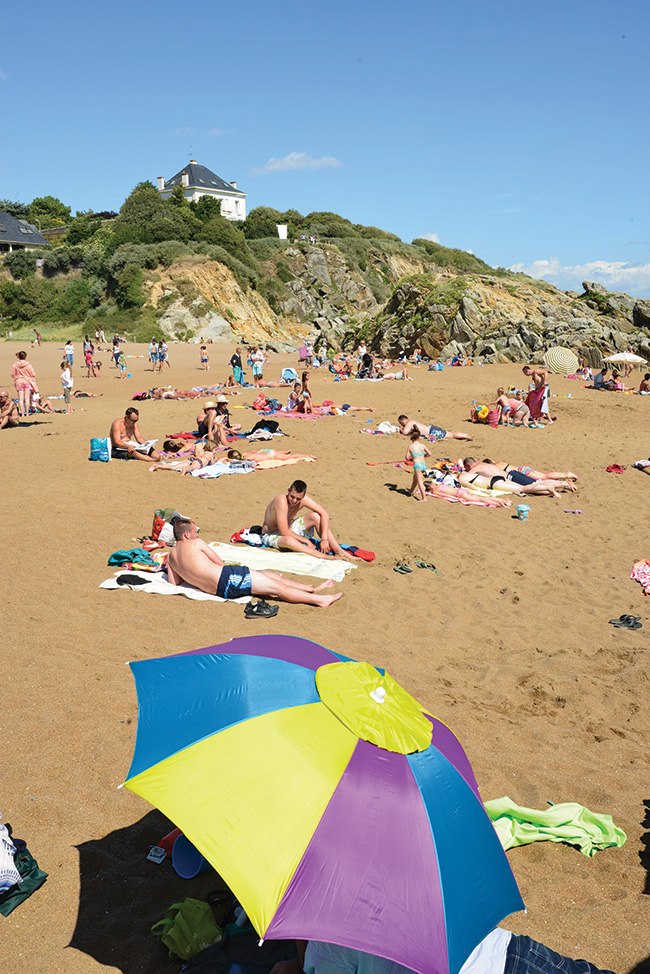
Tourists soak up the sun on the beach © SNAG
In the Escal’Atlantic visitor centre, you get a real sense of these luxurious vessels thanks to artefacts, lavish interiors from former ships and even sound effects for the full atmosphere. Explore recreated cabins, interactive displays and games, including one where you play the role of a shipping company director, making decisions about the route and various risks at sea. Information panels are given in English, and it’s a life-size, immersive experience… especially the exit, which you’ll have to discover for yourself!

All aboard a modern-day cruise ship © SNAG
Times of Adversity
Despite its glorious decades as the birthplace of transatlantic travel, Saint-Nazaire will forever be associated with war. Once again, the town’s strategic location made it a harbour of choice in 1917, this time for the American Forces who had joined the Allies and needed an entry point for reaching the western battlefields.

The statue of Sammy © SNAG
Over the following two years, around 198,000 troops came through the harbour along with 4,000 tonnes of equipment. The local population of 35,000 almost doubled with the number of Americans living alongside them, building infrastructures and modernising the town. A monument on the seafront recognises this unique relationship with the US troops. Nicknamed ‘Sammy’, the figure was commissioned after the First World War and depicts a US soldier flying in on the outspread wings of an American eagle, ready to defend the French people.
It’s impossible to imagine the shocking contrast for Nazairiens when their beloved hometown was taken over by German troops in June 1940. All traces of the elegant transatlantic liners were destroyed by the occupying forces, replaced by an imposing submarine base more than 300m long, which required a jaw-dropping 500,000m3 of concrete. An essential component of the Atlantic Wall, it housed the dreaded U-boats and hundreds of troops until May 1945.
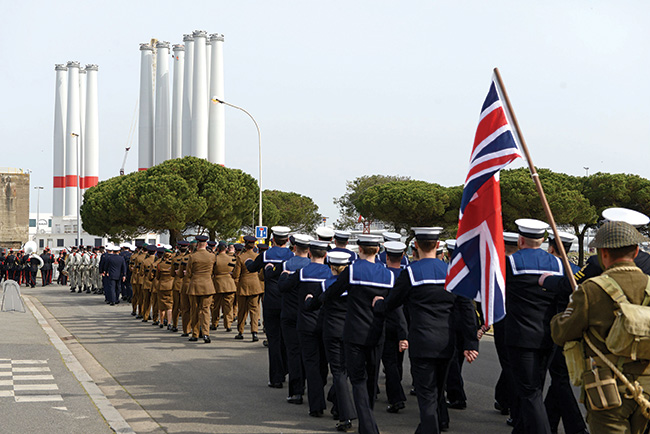
Parade of wartime heroes © SNAG
A Movie-Worthy Mission
This year marks 80 years since a daring raid in Saint-Nazaire that proved to be a turning point for the Allied victory. In January 1942, the German battleship Tirpitz was set to break through to the North Atlantic where it could decimate the Allied convoys, and four separate attempts to bomb it had failed. The only option left was to destroy the only dry dock big enough to accommodate the Tirpitz before she headed out on her deadly rampage – and that dock was Saint- Nazaire. Given the dock’s importance for the Germans, this was one of the most heavily-defended spots on the entire Atlantic coast.
The near-impossible plan, named Operation Chariot, was to pack the HMS Campbeltown with delayed-action explosives then ram it into the dock gate, blow up the ship and disable the entire dock. Getting in was hard enough; getting out alive would be a miracle. Now, if you head to the dock where the raid took place, you can follow a free, open-air circuit of illustrated panels (also in English) that tell the story through eye-witness accounts, including some by the heroes who made it out alive. It’s incredibly moving, particularly as you stand in those very spots, reliving the action and knowing that, thanks to them, the dock was rendered useless for the rest of the war.
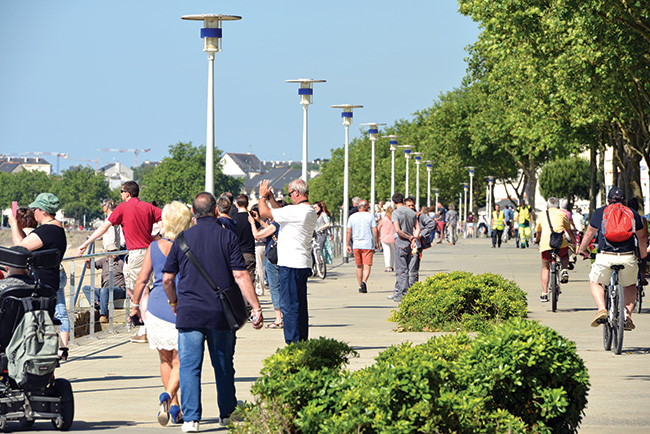
Saint-Nazaire’s busy seafront © SNAG
Exploring the Town
Saint-Nazaire always surprises first-time visitors with its modern art and contemporary architecture. The town commissions graffiti and murals by international artists, creating an open-air art gallery, free to the public and designed to be viewed from every angle.
On Place du Commando you cannot miss the large-scale sculptures of a foot, a pullover and the digestive system, placed on the shore; there are giant murals through the town centre, including the kids’ classic, Tintin, as one of his stories was based in the town. Children will love spotting the ‘little blue men’ known as Les Oides, created by an anonymous local artist (there are more than 500 to find!) and they’ll also appreciate the playgrounds in the centre, featuring irresistible sea dragons and giant eels.
Throughout the town, you’ll also spot numerous red triangles created by Felice Varini; climb to the roof terrace of the submarine base and you’ll find a precise viewpoint where all the triangles align to form a single, surprising artwork. You can download a free, bilingual map showing all the artworks across the town, and spend hours exploring, photographing and admiring.
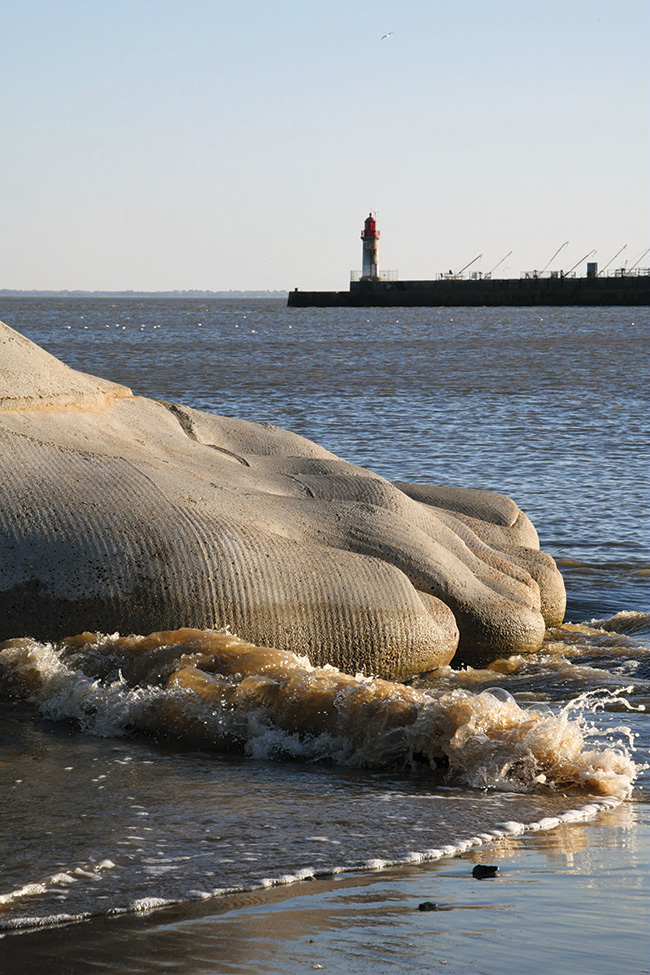
A sculpture of a foot in Saint-Nazaire, which is home to many public artworks© SNAG
Talking of exploring, don’t miss the sea-view bars and cafés on the Place du Commando, perfect for a spot of people-watching. There are also 20 beaches and creeks to choose from for a dip or to sit and relax a while, including one named after Monsieur Hulot, a character who comes here for his holiday in famous French film Les Vacances de Monsieur Hulot – you can see the statue that copies his famous stance, peering out to sea!
If you’re enjoying the wonderful seafront promenade, you can continue past picturesque fishing huts, head to the botanical garden and beyond to the famous GR34 coastal path that follows the entire coastline of Brittany. Or for a complete change of atmosphere, head inland to the Brière Regional Natural Park, an otherworldly area of wetlands, marshes, reeds and herons, where you can punt through weeping willows, meander around thatched villages and forget which century you’re in. Saint-Nazaire always seems to offer something unexpected, so that wherever you choose to go, you’re sure to be surprised, and you’re sure to find something that will make you smile.

Brière Regional Natural Park, where you can explore the wetlands by boat © SNAG
5 Unmissable Places in Saint-Nazaire
Saint-Nazaire is imbued with a rich history, much of it related to the ocean. Here are five historic attractions you won’t want to miss…
Escal’Atlantic
If you’ve ever wished you’d experienced the golden age of transatlantic liners, a visit to Escal’Atlantic could make your dreams come true. Stroll along the decks, explore the cabins, marvel at the luxurious fittings and relive the glorious heyday of traditional ocean liners.
Submarine Base
The Panoramic Roof Terrace of the Submarine base stretches out for over 300 metres, accessed by a ramp or using a lift next to the central ticket of ce. It’s well worth the ascent, offering a 360° view across the town and its impressive art installations.

Dissignac Tumulus dates back over 6,000 years © SNAG
Wartime Walk in Petit Maroc
Follow in the footsteps of wartime heroes who fought in Operation Chariot in 1942. Download the details or simply follow the circuit in the Petit Maroc part of town, learning about the historic raid through pictures and eyewitness accounts displayed on information panels.
Chantiers de l’Atlantique
Chantiers de l’Atlantique is a vast shipyard (one of the largest in the world) where modern ocean liners are assembled, and it is certainly a sight to behold. Book a guided tour and spend two hours feeling dwarfed by the 250-acre site, the gantry cranes and 3,000ft assembly area.
Dissignac Tumulus
For a step a little further back in time, head to Dissignac Tumulus, a burial chamber that dates back more than 6,000 years. Located just three miles from the submarine base, this tumulus contains two chambers and an engraved stone slab covered in mysterious symbols and images such as axes, a crosier and a sperm whale.
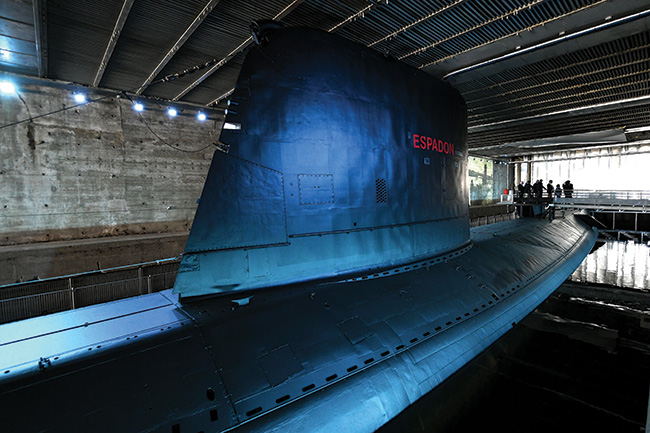
Espadon Submarine © SNAG
Up Periscope!
The U-boat base now has a far happier role housing tourism and cultural events, as well as the Espadon Submarine: the only oating submarine in France that you can board and visit. It’s an unforgettable experience, giving a sense of how claustrophobic life must be underwater for up to six days with 65 people. Sound effects bring everything to life, from snoring crew mates to beeping radar, and the English-language audio guide is delivered by the character of a young crew member so you can experience life as a submariner.
Saint-Nazaire Essentials
Getting There
Fly to Nantes Atlantique airport and you can drive (45 minutes) or take a train (1hr 10 minutes) to Saint-Nazaire. From Paris, there are several high-speed TGV links each day. By ferry and car, Saint-Nazaire is 2hr 30 from Saint-Malo, or 3hr 30 from Roscoff. Once you’re here, get around using the STRAN bus network.
Useful Contacts
Tourist Office
saint-nazaire-tourisme.uk
[email protected]
+33 (0)2 28 54 08 08
Brittany Tourism
From France Today magazine
Lead photo credit : The beautiful Atlantic coastline © SNAG
Share to: Facebook Twitter LinkedIn Email
More in best towns in Brittany, Brittany, Saint-Nazaire
Leave a reply
Your email address will not be published. Required fields are marked *




REPLY